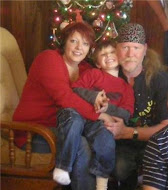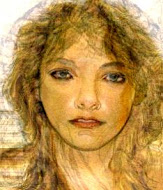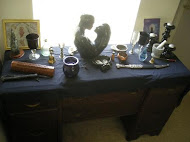* Song of the Otherworld is Heard In the Balance of Spring *
By C. Austin;
From http://www.celtic-connection.com/myth/v-equinox.html (this link is dead :( …)
Marking the dawn of the Celtic pastoral year, the vernal equinox celebrates the Otherworld in the moment of balance which occurs as the sun crosses the celestial equator. For the Celts, the solstice and equinox observations may have enjoyed less celebrity than the festivals of Samhain, Imbolc, Beltane and Lughnasadh. However, the semi-annual equinox was carefully noted, as it also brought increased visitation from the Otherworld. On the equinox, when day and night are momentarily equal, the busy activity which keeps the human and Otherworld separate momentarily subsides. In that time of suspended activity, the conduit between the worlds yawns, the "veil becomes thin." As the contents of both worlds mingle, the resulting tumult offers an opportunity for a renewed relationship with the unseen. An open mind is required for transacting with the Otherworld. As Yeats writes
"If he is skeptical about them, and would fain reduce them one after another to the rules of probability, this sort of crude philosophy will take up all his time."
Keep in mind that such meetings occur in a fleeting instant – longer dalliances in the world of mythos can lead to madness. It must be noted though, that those singular moments of insight can last a lifetime. Whether one believes such encounters are an external journey or an internal experience, they can be considered similarly. In both instances the contents and symbols of the Otherworld are approaching the individual from without or within. The equinox is just such a time when an association between worlds can be broached. By engaging in a simple ritual, perhaps a few minutes of silence, the frenetic conversations of everyday life recede, consciousness is reduced and the underlying song of the Otherworld has an opportunity to be heard.
The symbols which cluster around the Celtic observances of the vernal equinox and St. Patrick's Day are particularly evocative in creating associations which are as useful to us as they were for our ancestors. Through symbols like the leprechaun and the magic shillelagh, one can visit the fairy kingdom of the Tuatha De Dannan. Wise and giving, lusty and tempestuous, they offer their myths and enduring company. The snake and the trefoil shamrock give evidence of the presence of the Goddess, wrapped in her verdant cloak of Spring.
The four-leaf clover reminds us of the later solar worshipping invaders of Ireland, just as the leprechaun's pot of gold recalls the educated, priestly class of Druids who controlled the gold trade routes connecting Erin to continental Europe. T. L. Markey writes
"In the so-called primitive stage of many societies, webs of associations, highly symbolic in nature, are frequently woven between periods of the day, cardinal points, seasons, colors and social-spiritual values."
The "primitive" dialect of symbols which was created by our ancestors still exists in our unconscious minds. These symbols are composed of both personal and universal matter, and it is our association with those symbols which allows us to hear the language of our soul. Tending to those associations tends to the soul and renews the ligature that binds mortal to mythos. This year as you celebrate St. Patrick's Day or the equinox, take a moment to enjoy the multi-layered experience of our ancestors.
Disclaimer: No one involved in this blog or its contents may be held responsible for any adverse reactions arising from following any of the instructions/recipes on this list. It is the reader's personal responsibility to exercise all precautions and use his or her own discretion if following any instructions or advice from this blog.















No comments:
Post a Comment